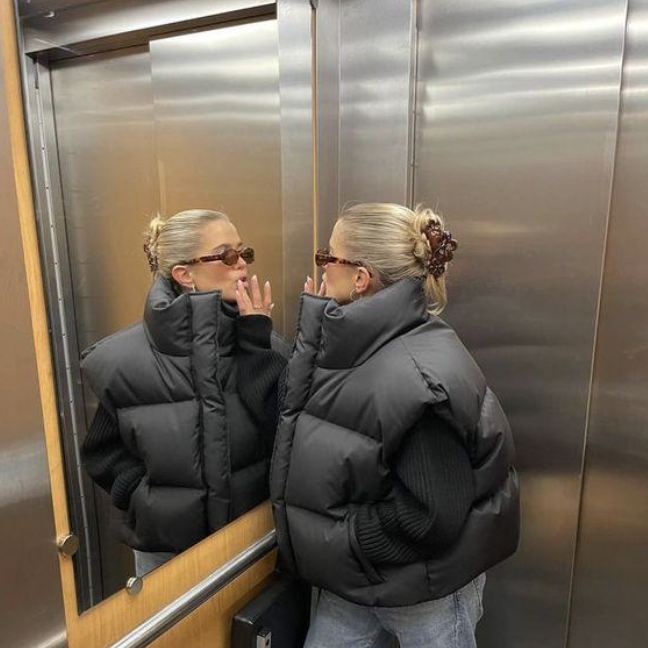Function vs. Fashion: A Philosophical Approach to College Fashion Trends
Written by Katherine Rubinstein
I can't remember the last time I reached for my fluffy Urban Outfitters teddy bear jacket I used to wear everyday in 2019 (thank you, Emma Chamberlain). I loved it, though. Just like all trends, it was exciting, nuanced and made me feel more connected to other girls my age who were watching the same YouTube videos I loved. While I knew the jacket probably wouldn’t be something I’d be wearing in 10 years, it served a purpose for my 15-year-old self who had to wake up before sunrise everyday for my 8-hour day at high school.
Now, as a college student, this emulation of social relevance isn’t in some giant fuzzy coat anymore; it’s in brown Tasman Ugg slippers, a black Aritzia ‘The Super Puff’ jacket or a black Longchamp tote. These trends distinguish themselves from ones like my jacket because they are more versatile, immersed in neutral colors and devoid of any pattern, numbers or letters. At best, you can see the brand logo – lost in a mass of an earth-toned brown that makes up the rest of the piece.
This phenomenon is not as simple as the designs themselves. Simple pieces like a black dress or a white long sleeve have been praised for years by even the most famous of fashion designers, like Coco Chanel. What happens, though, when trends are starting to become what was once considered to be timeless?
Attending school in Madison makes investing in versatility worthwhile; the cold weather, daily long walks to lectures (sometimes up a certain treacherous hill), being one amongst a surplus of other people⸺the list goes on. The clothes students tend to wear to class are particularly fascinating because they almost completely eliminate any creative effort as people prioritize comfort, convenience and warmth. If you walk into the Starbucks on State Street at 10 am on a weekday, you’ll be met with a sea of students on their way to class wearing the following:
Puffer vests – A no-sleeve down-jacket that’s good for when the weather is unpredictable.
Gold hoops – Simple and potentially cheap earrings that work for both formal and informal occasions.
Artitzia’s ‘The Super Puff’ – A largely popular down-jacket sold in solid colors and often advertised by celebrities via social media.
Mini Ugg boots/ Ugg Tasman slippers – Wool-lined suede shoes that function both indoors and outdoors.
Adidas Sambas – An athletic-turned-streetwear staple sneaker.
Boston Birkenstocks: A “laid-back” suede unisex clog (Birkenstock.com).
Longchamp ‘Le Pliage Tote’: Bag – often black – that fits all school-related material and matches every outfit
Claw Clips: Hair accessory that clips back hair into a neat fold.
Trends like these can eliminate opportunities for personal style to serve as a distinct form of art because they prioritize utility over creativity and self-expression. The appeal of these items, to keep people warm and comfortable, amongst others, provide a sense of social affirmation in knowing that what you are wearing is appropriate for the “event” you will be wearing it to.
Psychiatrist Carl Jung’s theory, the collective unconscious, postulates that there is a collective mind inherited by all mankind. This includes memories, instincts and basic knowledge living in the subconscious region of our psyches. When we meditate or sleep, we are taken back to this collective origin in our subconscious minds. Art is often used as a vessel to reach our collective origin. For example, through music at concerts or at religious ceremonies like a church service. The art of fashion trends, like wearing a claw clip, can also be considered a conduit in this framework that can similarly allow us to find meaning in our lives. This theory implies that versatility in trends themselves is nominal to the action of connecting with others. Thus, if the trend were to be to wear extravagant things all the time as a medium of expressing something specific to ourselves, it would serve the same purpose as the trend being neutral colors. This is because it’s a collective act.
One of the most famous Confucian philosophers, Menicius, said around 350 B.C. that "the myriad things are complete in us. There is no greater joy than to reflect on ourselves and become sincere." To simplify: there is an innate goodness in people, and there is a process of discipline that makes people become better and better. Therefore, it can be assumed that trends in general are inherent to our nature and are part of our “goodness” as human beings. However, it can also be argued that creativity, education and awareness of more explorative fashion can allow us to enhance our said goodness.
I spent my freshman year of college in Florence, Italy and New York City. Now living in Madison, the difference in everyday attire has proven itself to be a customary difference. The formality in the Italian lifestyle is a way for people to show respect for the situation they’re in and the people they’re sharing it with. New York, on the other hand, is one of the four most prominent fashion capitals in the world. There’s less fear involved in wearing something experimental because so many others are, too. You can be equally stylish through wearing the glamor and campiness of sequins, or with the grunge of oversized jean shorts. The point in comparing the fashion scene in Madison to scenes in Italy and New York is to illustrate how fashion is always serving a function, and that function is dependent on its environment. “Functionality” transcends simply feeling comfortable and secure, but more broadly feeling good.
Luckily, there are still trends circulating now that are more outside-the-box, like cowboy boots, ribbons, and snapback hats. They’ll take us back to this time, and we’ll be reminded of where we were, of what we were doing, and of the people we were wearing them with when we were college students.
Edited by: Sophia Buckholtz, Mia Quigley, Helen Song, Olivia Daly, Esti Goldstein, Lauren Veum, and Hana Razvi





